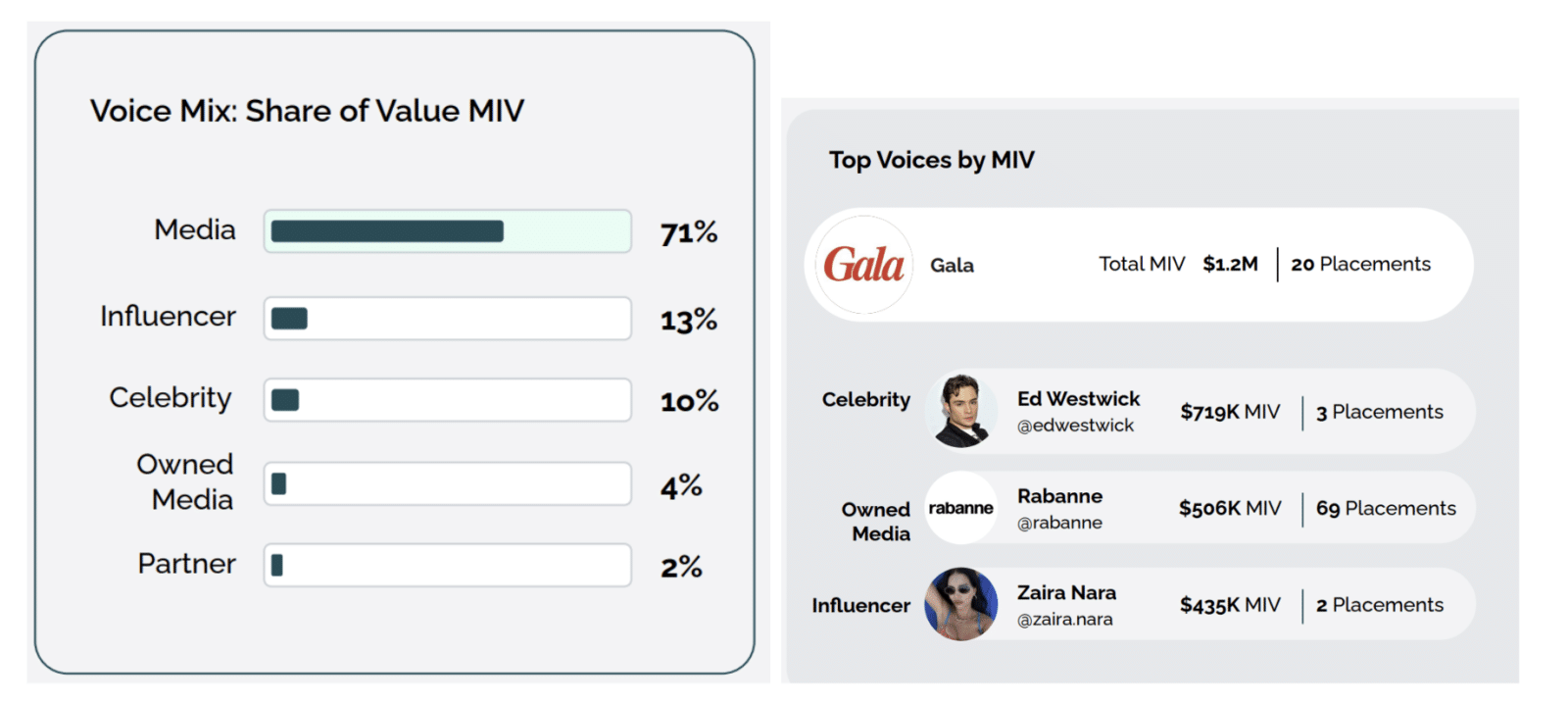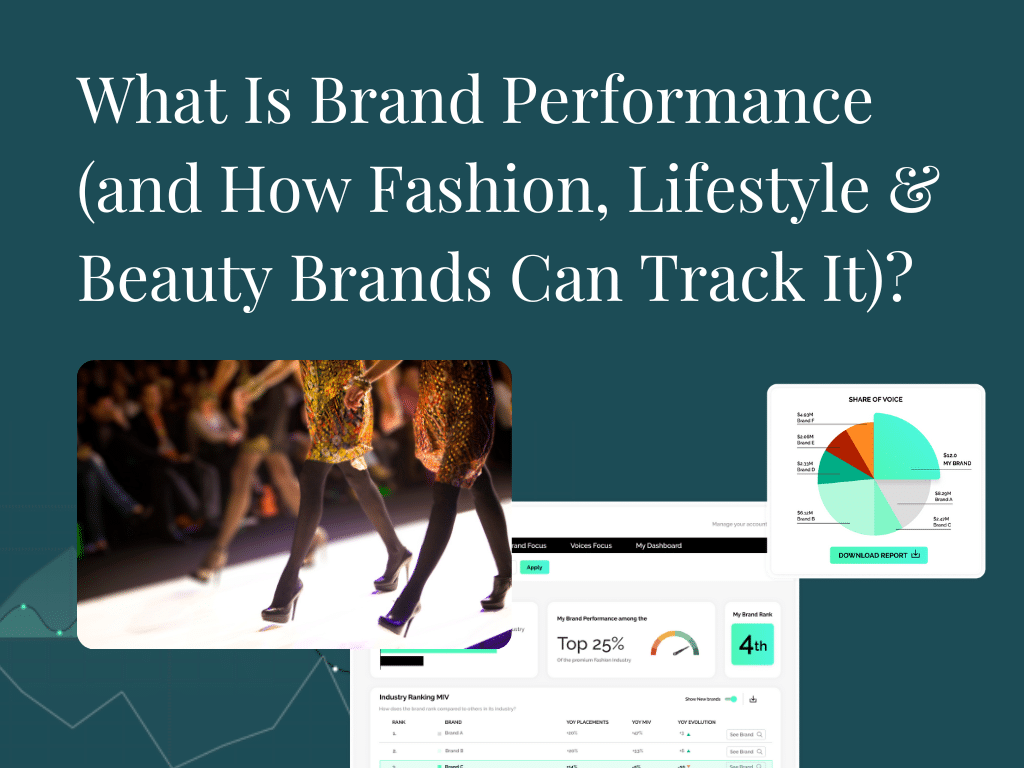Today, brand perception is one of the (if not the) most essential purchase-drivers for shoppers. With companies in Fashion, Lifestyle and Beauty (FLB) continually being put to the test thanks to economic pressures, ongoing global political issues and the growing share of wallet of younger consumers, people are hyper-aware of what brands truly value, and how they communicate this. In fact, the brand itself can represent a huge portion of a company's overall value. Take L’Oréal’s $2.5B acquisition of Aesop—this record-breaking sale was the cosmetics giant’s largest-ever buyout, and experts attribute the high figure to Aesop’s strong brand equity.
However, the question arises as to what really builds this brand value, and how you can determine which marketing activities are more valuable than others. Is value being built by media mentions and how your brand is perceived by authoritative publications? Is value being built by influencer and celebrity activations or how they speak about your company? Or, is the value being built by how you market your brand on your website or owned media channels?
The answer is all of the above. And, with both industries and brands being totally unique in how they see success, there is a necessity to quantify and compare marketing activities against each other, to calculate, benchmark and determine the right strategy for you.
That means, ultimately, your brand performance is what should truly drive your strategic decision-making. But how do you measure it? Which metrics and brand performance indicators should you use? Read on as we answer these questions and more below.
In this article you’ll learn…
What Is the Definition of Brand Performance?
Brand performance refers to the measurable impact of a brand's activities on its market presence, consumer perception and financial outcomes. It’s the intersection of how a brand is perceived (its image and reputation) and how it delivers on its promises (its tangible results).
In essence, brand performance answers two critical questions: How is the brand resonating with its target audience? And, is it meeting its business objectives?
These days, it’s no longer enough to offer a good product or service; customers demand a seamless experience, an emotional connection and proof of your brand’s commitment to its values. Tracking brand performance is important because it provides a clear indicator of long-term brand health and ensures brands can remain agile and optimize their strategies for sustainable growth. Measuring your brand’s performance helps you understand what works, what doesn’t and how to pivot as needed to stay on top of your game.
How to Measure Brand Performance (Using Brand Performance Indicators)
We’ve established how important brand performance is, but how do we actually quantify or calculate it? Below, we’ll break down some of the specific brand performance indicators and key metrics that provide measurable insights into your brand’s impact. It’s also important to consider the best approach to implementing these measurements.
Let’s start by exploring three essential things you need for effectively measuring brand performance: a Voice-centric approach, a standardized metric and a holistic view.
1. A Voice-Centric Approach
The best way to measure brand performance is to examine it from a cross-Voice approach. You want to consider each and every marketing initiative your brand runs in order to see what’s working, or what areas you might be missing out on. This approach takes into account the five key Voices that are influencing customer buying decisions today:
- Influencers
- Celebrities
- Media
- Owned Media
- Partners
Using a Voice-centric approach gives you a way to organize and interpret your brand performance data to make it more meaningful and actionable. For instance, instead of just tracking engagement and reach levels on a platform like Instagram or TikTok, a Voice-centric approach allows you to understand which Voices deliver the best results and identify the ideal Voice mix for your brand's success. When used in conjunction with a standardized metric—such as Media Impact Value® (MIV®), which we’ll look at below—you can compare how Voices perform across different platforms, in different regions and even between online and offline initiatives.
2. A Standardized Metric: Media Impact Value® (MIV®)
To translate raw data into an actual, calculable ROI, you need the right metric. At Launchmetrics we utilize our proprietary metric, Media Impact Value® (or MIV®), which measures the impact of placements and mentions across these five key Voices in the Fashion, Lifestyle and Beauty industries. This allows us to compare an influencer activation or campaign with a press mention in order to determine which is offering the most value to a brand.
MIV is a powerful metric as it analyzes both quantitative and qualitative attributes—more than 100 of them in fact—including content quality, audience engagement, industry relevance and more, to create a highly accurate method of measurement. And because it gives you a dollar value on every media mention, post or marketing activity, it’s easier to calculate how brand equity is being created and optimize your strategies accordingly.

In the above data for Rabanne from our SS25 Fashion Week Report, we can see that the Media Voice drove the most value for the brand during their Paris show. Using MIV, we can also discover which specific Voices performed the best and across how many placements. This is an example of how a Voice-centric approach and MIV can be used together to gain insights into brand performance during a specific event or campaign.
Share of Voice (SOV)
A related key metric for measuring brand performance is SOV, which helps you understand how much of the conversation your brand owns in relation to competitors. Analyzing this gives you a good idea of your market presence and influence within the industry. You can also use SOV metrics to identify the most talked about brand during a particular event.
When combined with MIV, SOV provides a deeper understanding of not just how often your brand is mentioned, but the quality and value of those mentions, helping you build a more comprehensive view of brand performance.
3. A Holistic View
Another thing to be conscious of in your approach to measuring brand performance is internal vs competitive benchmarking.
On the one hand, it’s absolutely necessary to benchmark against your own goals and past performance in order to stay on track and build your brand. But equally, benchmarking competitively is a crucial component. Your brand doesn’t exist in a vacuum, and you need to know where you stand in relation to competitors.
For example, it’s always great to observe whether this month you accumulated more MIV than last month, but what if, relatively speaking, you never had a high MIV compared to the industry standards? Moreover, wouldn’t it be interesting to know that while, yes, your MIV might not have increased, the industry’s average for your competitors has decreased in the meantime? All of these questions, when supported by data, can reveal a lot about how you should adjust your strategy along the way in order to optimize your brand performance and in turn, support your business.
Boosting Brand Performance: Two Key Areas to Focus On
Further to the above, we also want to highlight two key areas of brand performance to focus on and measure in order to drive growth and meet marketing objectives.
Content Performance
With most brands opting for omnichannel marketing strategies thanks to the huge increase in consumer touchpoints and the current 'age of social media,' it's essential to understand how different content performs. 60% of brand budgets in Fashion, Lifestyle and Beauty are being invested into creating, amplifying and measuring content, and with large monetary flows, teams need to be able to justify the cost of this content production and amplification.
“From a content perspective, every piece of content has to really hit all of your brand markers,” says Nicole Baum, Global Head of Marketing for Moschino, in our masterclass “A Complete Guide to Marketing Budget Optimization”. She explains that using the right KPIs is important for understanding the deeper impact of the brand’s marketing campaigns. “We know there are a lot of platforms in which we can’t expect direct sales, especially social platforms,” says Baum, “so we need to look at the overall impact of our marketing investment and the impact that has on sales.”
Whether you’re building your brand performance through user-generated content (UGC), iInfluencer partnerships or oOwned channels, it’s crucial to understand how each piece of content is performing in order for your content strategy to evolve. Metrics like engagement rates, reach, click-throughs and conversion rates provide valuable insights, while MIV offers a clear, standardized way to evaluate ROI for every piece of content.
Creating Impactful Experiences
To reiterate; consumers are changing—and what they expect and demand from brands is changing, too. Today’s customer is all about immediacy, being at the right place and at the right time, and your brand needs to understand if you are meeting this standard through your brand assets and brand experiences.
Making consumers feel part of an experience, whether digital or physical, has become front-of-mind for brands in the FLB industries today. The experiences that brands craft have to be share-worthy in order to encourage key industry leaders as well as customers to share and talk about these events on and offline.
Practical ways to create impactful experiences include hosting immersive events, leveraging augmented reality (AR) for digital experiences or creating interactive social campaigns. For example, a pop-up event showcasing your latest collection can be paired with a social media challenge that encourages attendees to share their experiences online.
To measure effectiveness, track the mentions your campaign generates across media and social platforms, monitor website traffic for spikes in activity, analyze the sentiment of the conversations around your brand and use MIV to evaluate the financial value of these interactions.
Brand Performance Checklist
Brand performance encompasses metrics around sales and financial performance, such as customer retention, customer acquisition cost, profit margin analysis and product performance. However, from a marketing perspective, it’s also crucial to consider broader brand-building metrics. The checklist below can help ensure your brand is covering off on all of the ones that matter most.
Brand Awareness
- Social Media Mentions: Monitor the frequency of your brand mentions (and the quality of them!) across social platforms.
- Website Traffic: Analyze the volume and behavior of visitors to your site.
- Search Volume: Track how often your brand is searched online.
Audience Engagement
- Social Media Interactions: Measure likes, comments, shares, and follower growth.
- Email Open and Click-Through Rates: Evaluate the effectiveness of your email marketing campaigns.
- Content Engagement: Assess how users interact with blog posts, videos, and other content.
Brand Sentiment
- Customer Reviews and Feedback: Analyze the tone and key themes in customer feedback.
- Net Promoter Score (NPS): Measure customer loyalty and satisfaction by tracking how likely customers are to recommend your brand.
Market Positioning
- Share of Voice: Compare your brand's presence, impact and visibility to that of competitors in your industry.
- Competitive Analysis: Evaluate competitor strategies, performance, and market share.
Digital Presence
- SEO Rankings: Monitor your brand’s position in search engine results for relevant keywords.
- Online Advertising Metrics: Analyze the performance of digital ad campaigns, such as impressions, clicks, and conversions.
Public Relations
- Media Coverage: Track the quantity, reach, and sentiment of press mentions. Use MIV to assign a monetary value to your media coverage and understand its contribution to brand equity.
- Influencer Partnerships: Assess the ROI and impact of collaborations with influencers by analyzing their reach, engagement, and the value generated through metrics such as MIV.
Conclusion
Summing up, measuring and improving your brand performance is key to refining your overall strategy and building long-term brand equity. As consumer expectations continue to evolve, having actionable insights and a deep understanding of industry dynamics is essential for gaining an edge over your competitors. To understand more about how to build brand performance and the tools you can use to do so, explore our Brand Performance Cloud below.

